O tyt zeer lustich vul melodyen
(O time so heartily full of melodies)— title of a composition by Tielman Susato, c. 1510/1515–c.1570
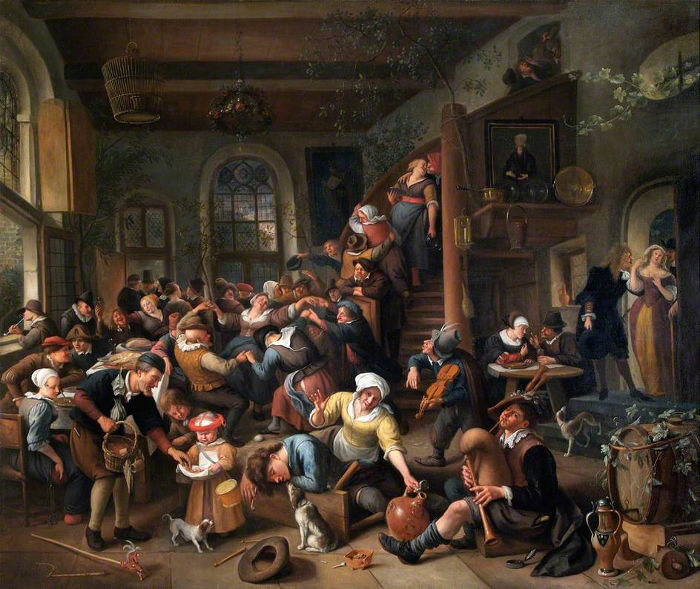
Jan Steen
c. 1674
Oil on canvas, 110 x 135 cm.
London, Wellington Museum,
Apsley House
Peasants dance wildly around an egg lying in chalk circleThe "Eierdans" (translated as "egg dance") is a traditional folk dance that was popular in the Netherlands, with historical references dating back to the seventeenth century and possibly earlier. It's a part of a broader European tradition of egg dances, which were common in various forms across the continent. In the sevneteenth -century Netherlands, the egg dance would typically involve the following elements. The dance involved dancers moving around eggs that were laid on the ground. The challenge was to dance among the eggs without breaking them, which required skill and careful footwork. Often, the eggs were arranged in a chalk circle. Dancers would enter the circle and perform intricate steps and movements, taking care not to damage the eggs. The egg dance had symbolic meanings. Eggs have long been symbols of fertility and new life, and the dance could have represented the coming of spring, especially around Easter time. The egg dance was likely performed during festivals and community celebrations. It might have been especially popular during Easter, but it could also have been a part of other local or seasonal festivities. drawn on the floor of sordid inn to the hypnotic music of the fiddle and a bagpipe (fig. 1). In front of rustic tavern villagers and their children listen with rapt attention to a beggar playing a hurdy-gurdy while the reek of cheap drink and tobacco hang over the scene (fig. 2). Even the innkeeper has been lured to the doorway to listen to a few notes of music.
Neither of the immensely popular scenes, painted and sold thousands of times, ever disturb the perfect calm of Vermeer's oeuvre. With the exception of a single working-class milkmaid, Vermeer represented the exceptional lifestyle of the young Dutch cultural elite engaged in sophisticated pastimes. Some of the musical instruments in his paintings were luxury items destined for the few. Certainly, they would have never appeared in the hands of a beggar. The refined music which we would have heard in Vermeer's compositions was of French or Italian origin.
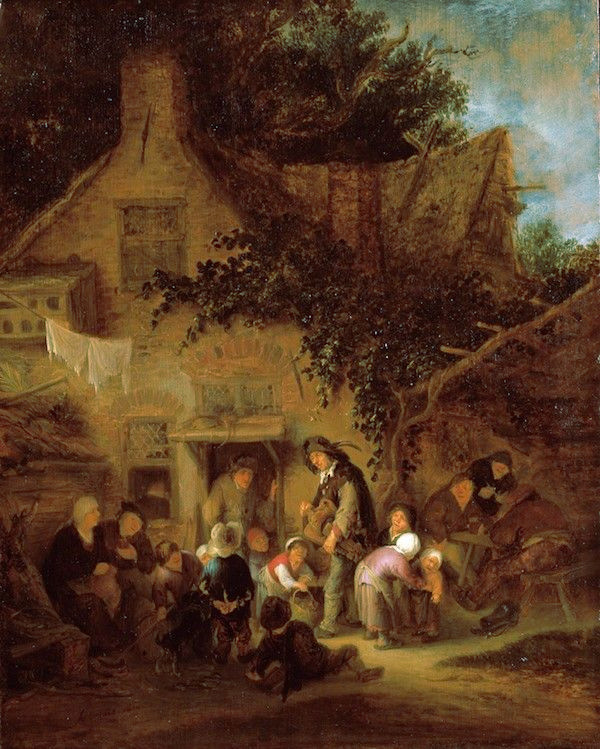
outside a Tavern
Adriaen van Ostade
1640
Statens Museum for Kunst,
Copenhagen
The reason why Vermeer chose to travel the "high road," taken by a limited number of fijnschilders (fine painters) rather than the "low," taken by an army of Dutch artisan/painters, is lost in history. He left no writings, his name and art were barely mentioned in the chronicles of his time.
However, Vermeer's choices of motif hardly means he was unfamiliar with the everyday low-life scenes. Quiete the contrary: as the only son of an innkeeper he grew up in taverns where drinking, smoking, business, cavorting, and music-making all meshed together amid pictures from his father's art trade.
Moreover, the stepfather of Vermeer's father Reynier, Nicolaes ("Claes") Corstiaensz. van der Minne, was, a professional musician, a so-called speelman,See the online-genealogy Alweer-een-Vermeer: De familie van Johannes Vermeer (1632–1675): "Niclaes ("Claes") Corstiaensz van der MINNE, kleermaker en speelman" (Dutch: kleermaker = taylor). aside from being a taylor. We know that Nicolaes had played on the occasions of public festivities or whenever he was called on.John Michael Montias, Vermeer and His Milieu: A Web of Social History (Princeton, NJ: Princeton University Press, 1989), 11 He possessed various instruments, and it is probable that Nicolaes had instructed his son to play some kind of musical instrument, perhaps a flute. Thus, Reynier grew up in a musical family. It would be only logical to suppose that he imparted to his own two children Gertruy and Johannes a hearty sense of enjoyment for music common to the Dutch people at large. Although there is no proof, it is enticing to believe that his family musical connections have something to do with the elevated number of musical themes he painted.
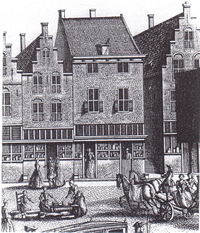
Leonard Schenk after a drawing by Abraham Rademaker
c. 1730
Engraving, 57 x 98 cm.
Gemeenarchief, Delft
Very likely, Johannes was born in the house which doubled as an inn (combined living and working quarters were the most common arrangement in seventeenth-century urban Netherlands) called De Vliegende Vos ("The Flying Fox") at Voldersgracht, northern from the Grote Markt. However, in 1641, when he was nine years old, his family of four moved up in the world a to a larger tavern called Mechelen (fig. 3), on the corner of Markt and Oude Manhuissteeg (Old Men's House)Opposite this alley and bridge, the Oude Mannenhuis (Old Men's House) was located on the Voldersgracht from 1411. This institution consisted of a number of rooms or houses around a courtyard and a chapel. From the middle of the 17th century, it was used as the Sint-Lucasgildehuis (Guild of Saint Luke House). The entire complex was demolished in 1876 for the construction of a primary school, and it was reconstructed in 2007. even if it was only a few paces away. This new location (father Reynier must have been prospering well since he could afford to buy the expensive piece of real-estate) had a far better commercial exposition with the added advantage of having far more space for promoting his picture trade. Both The Fling Fox and Mechelen were frequented by a host of both established and lesser-known artists and artisans, for eating, drinking and naturally, shop talk with Reynier.It is very likely, that Vermeer, after his father's death in 1652, and beside his professions as a painter and art dealer as well as his official duties soon to follow in the Guild of Saint Luke, frequently helped his mother Digna Balthens running the tavern "Mechelen," even in her last years, until it was let out in 1669, short before Digna died in early 1670. This might also be one of the reasons for Vermeer's small oeuvre.
It was not unusual for art dealers or even artists to run an inn or brewery like the great genre painter Jan Steen (c. 1626–1679). In 1654, Steen's father signed a contract to rent the brewery De Roscam at the Oude Delft for his son, which he had run until 1657, unfortunately with scarce success. In those times, many painters who were unable to support their families exclusively by their art resorted to a second business to hopefully provide more stable income. Beer consumption was enormous in that times. It was already drunk at breakfast time (even though the alcoholic content was inferior to today's beer), normally in an inn, the central meeting point in the social life of the middle and lower classes. But fierce local competition and the arise of qualified breweries in surrounding cities made brewing do-or-die business in Delft.
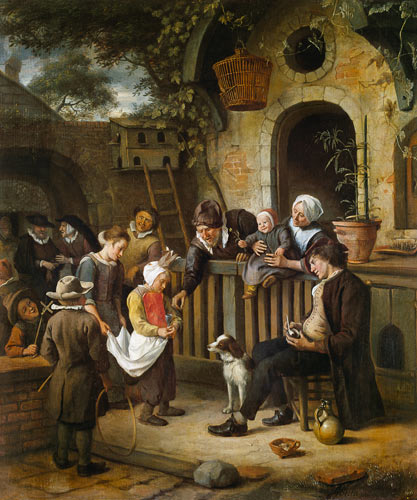
Jan Steen
1664
Musée du Petit Palais, Paris
Inns and taverns were attractive for a less obvious reason: they offered more space and light than the dark and narrow rooms in the cramped houses of the common people. Being one of the prime gathering points, people found them comfortable for conducting business. Weddings, funerals and most of the secular and religious festivities were celebrated in the inns and taverns, documented by an endless number of painted rustic scenes. Perhaps the best in this line of painting were the Fleming Pieter Brueghel the Elder and Steen himself (fig. 4, 5 & 6).
However, all was not fun and laughter as the painted images would lead us to believe. Heavy drinking, a little raillery gone too far, a wrong word at the wrong time were more than enough to excite temperaments and light a fire that was impossible to snuff out. The results could be lethal. A typical example of this kind of early Dutch realism is Adriaen Brouwer's Peasants Fighting, a subject which he repeated several times. The Dutch saying "100 Dutchmen, 100 knives" reminds us that Brouwer's scenes, which were avidly collected and imitated, were evidently not too far removed from real life. Vermeer's own father testified as a witness in legal proceedings regarding a knife fight which broke out during an iceskating outing with his friends.
Returning to Vermeer's childhood, to live in a tavern on the Grote Markt meant to live in the very heart of Delft. The future painter and his family were instantaneously in touch with most any official event, whether religious or secular. As a boy he witnessed and took part in the local customs which unfolded in relentless succession during the course of the year.
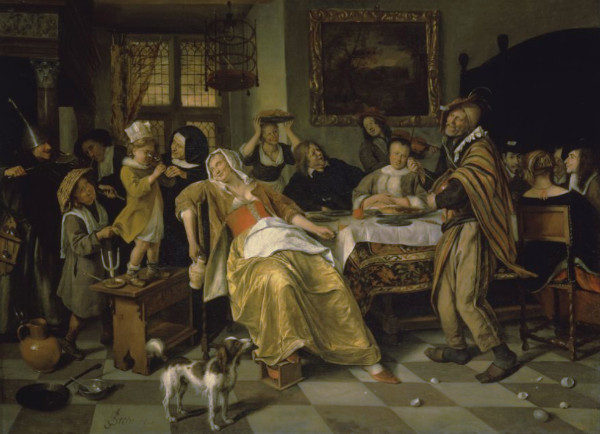
Jan Steen
1668
Oil on canvas, 80 x 105 cm.
Museumslandschaft Hessen Kassel, Gemäldegalerie Alte Meister
At Driekoningen (Epiphany, January 6) children went through the street in groups of three. Boys dressed as the Holy Three Kings waved stars made of gilded paper. They played their rommelpots and sung one of the popular sterrenliedjes, asking for some sweets or a few pennies. On Palm Sunday, Delft children paraded through the streets and alleys during palmpaaslopen waving wooden crosses, decorated with colored stripes of paper, colored eggs, cookies in the shape of hens, swans or ducks while singing a palmpaas-song.
Another popular procession was the Pinksterblom"Pinksterblom," also known as "Pinksterbloem," refers to a tradition in Dutch folklore associated with the celebration of Pentecost (Pinksteren), a Christian feast marking the descent of the Holy Spirit upon the Apostles. The term translates to "Pentecost flower" and is typically identified with the cuckoo flower or lady's smock, which blooms in spring around the time of Pentecost. Historical Dutch Pentecost celebrations involved various customs, including decorating homes and churches with flowers like Pinksterblom, holding festivals and fairs with music and dancing, creating a "Pinksterkroon" (Pentecost crown) adorned with flowers and ribbons, and the "Pinksterbruidjes" tradition where young girls dressed in white would sing and dance for treats. Over time, many of these folk traditions have diminished, though Pentecost remains a religious holiday in contemporary Netherlands. at Pentecost when children were baptized to commemorate the descent of the Holy Spirit upon the followers of Jesus Christ. The year before, one girl had been chosen to take part in the following year's procession. She decorated her hair with white ribbons and a special white flower and went about from house to house, singing one of the popular Pinksterblomliedjes. Passerbyes and people who came to their doors and tossed a few pieces of fruit, sweets, or coins in a cup held by the Pinksterblom-girl. Later, the girls met again and chose the Pinksterblom for the following year and shared what they had collected. In Amsterdam and Haarlem, the municipal officials attempted to prohibit Pinksterblom, calling it "lichtvaerdig en onnut" ("frivolous and useless"), but without measurable success. Thanks to Jan Steen, we have a loving depiction of the procession, De kleine collectant (c. 1664).For detailed information about ancient customs and songs in the Netherlands see Marita Kruijswijk and Marian Nesse, Nederlandse jaarfeesten en hun liederen door de eeuwen heen. Hilversum 2004 (with CD). See also their website: http://www.xs4all.nl/~marianta/. An overview (English) to seasonal feasts in the Netherlands is to be found here: http://www.sacred-texts.com/etc/fwe/fwe09.htm
We must not forget that people's lives in former times were intimately bonded to the sequence of the seasons. Common folk had deeper ties with ancient customs and religious and secular festivities. These festivities furnished a welcomed break from the hardships of daily life and a chance to work off a bit of steam in a more or less accepted manner. Sinteklaas (Saint Nicolaus), Kerstmis (Christmas) and Driekoningen helped to bring relief to the long gelid Dutch winters, especially for children. With the closing of winter there was nothing more delightful than to sing and dance around the meiboom at the first of May, as can be seen in an illustration to Jacob Cats' Spiegel Van den Ouden ende Nieuwen Tijdt.
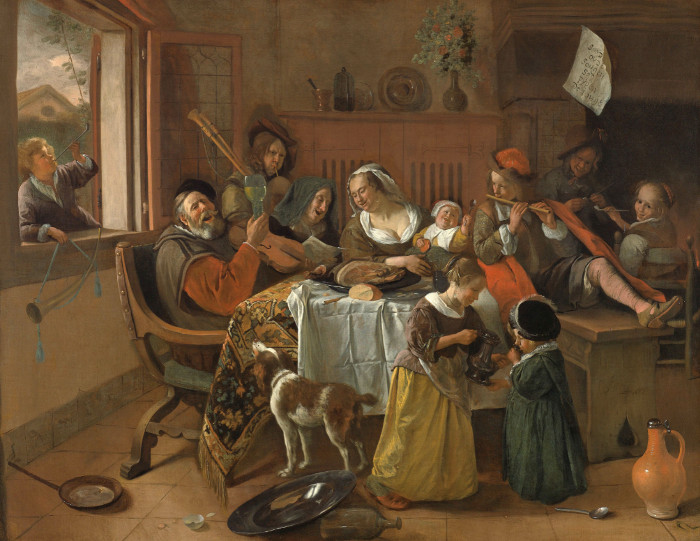
Jan Steen
1668
Oil on canvas, 110.5 x 141 cm.
Rijksmuseum, Amsterdam
Click here for period music:
Song of the Whitsun-Flower
recorded at the isle of Terschelling
A Whitsun-song from the island of Terschelling in the northern part of Holland. On the first Whitsun-day in the village of Westerterschelling, a little girl, dressed in her very best and decorated with all the silvery things the family possessed: spoons, forks, medals, rings, broches, etc. goes around the village with her play-mates. She was covered with a shawl, but the beautiful silvery things she wore under the shawl, were showed to everybody who gave some money. For the money they received, the children bought sweets.
:
Folksongs and Dances of the Netherlands, Collected and notes by Wilhelmina D. Scheepers.
In addition, large-scale fairs and a variety of markets dotted the calendar some of whose locations still bear their original names like Paardenmarkt, Koornmarkt, Beestenmarkt (where Vermeer's father Reynier had grown up). Of course, jugglers, clowns and musicians good and bad were inseperable animators of every popular event. Singing and dancing provided a valuable social rolebeing one of the few chances for young men and women to openly meet and find a suitable partner for marriage. One such merry gathering of a family and friends can be seen in Jan Steen's famous Driekoningen ("Twelfth Night") or Merry Family (see The Bagpipe),
Thus, all told, the great Vermeer had witnessed far more traditional song and dance of the common people than the "classical" music of the wealthy upper class.
Many paintings show a fiddler with someone playing the bagpipe, the most common musical instruments for rustic dance music in that times. The hurdy-gurdy was the preferred instrument of the itinerant beggars, appearing here and there in seventeenth-century paintings. But there were still other instruments, like the shawm or the dulcian, employed especially by the stadsmuzikanten for the outdoor playing at official events, like proclamations or processions. Some special instruments, rarely or not to be found in paintings, but adding some additional 'color' to the music with their distinctive sound, are the rommelpot, the crumhorn, the 'hommel' (a fretted zither) or the mystical Midwinterhorn, which are hardly known today, but were in common use in Vermeer's time.
This study attempts to shed some light to traditional Music and Dance and acquaint us with some of these unfamiliar instruments. A few were hardly "simple" ones, as Edwin Buijsen has called them.Edwin Buijsen, "Music in the Age of Vermeer," in Dutch Society in the Age of Vermeer, eds. Donald Haks and Marie Christine van der Sman (Zwolle: Waanders Publishers, 1996), 110. On the other hand, the hurdy-gurdy, an instrument of ancient origin, is amazingly complex in its structure, comparable to that of the violin or fiddle.
Traditional Music and Dances in the Low Countries
The music of the Netherlands is not renowned for its elevated quality. There was a scarcity of first-rate indigenous composers capable of fulfilling the needs of their own people and to compete with those of the great nations of music, France, Germany, England and Italy. This may be part due to the excessive "openess" determined by their unique geographical situation and political history. Jan Pieterszoon Sweelinck was indeed the last and, perhaps, the only top tier Dutch composer.
The Low Countries consequently shared most of their traditions with neighboring areas in Germany and France and to some degree with England. Since the Middle Ages, the Netherlands had also been among the most urbanized areas of Europe, there was a continuous cultural interaction between social classes.
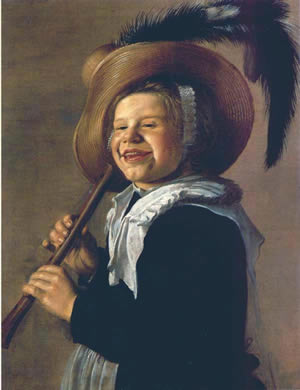
Jan Miense Molenaer
1661
Private collection
Since traditional music, both vocal and instrumental, was transmitted by "mouth" or by "hand," far more than classical music, "folk" music had not been written or published before the middle of the sixteenth century. "The Tech Multimedia Music Dictionary." defines folk music as "music of the common people that has been passed on by memorization or repetition rather than by writing, and has deep roots in its own culture." Children learned to sing and play a simple instrument (like the rommelpot or a discant recorder, see Jan Miense Molenaer's lovely Girl with a Recorder (fig. 7) within their families or in the midst of street processions, feasts or while listening to itinerant musicians at the fairs or markets.
A "semi-professional" fiddler may have taught his sons or others to play the fiddle, but hardly within a regulated master/apprentice-system, which was the norm for learning an art or craft. It was strictly learning-by-doing, practicing and following the "master" to the fairies and markets, the best places to learn how to perform and improvise according to tradition and the current tastes of the people. While traveling from town to town or even from province to province, each musician come by an infinite number of catchy new melodies, which could then be suited to his own repertoire and talents. Many melodies, true "hits" in their native countries, were spread by traveling musicians. It is not by chance, that many religious songs we know today, stem from traditional dance melodies, frequently popular in several countries at once.
"Speelman, gij moet strijken" – freely translated, "Musician, grab your fiddle" – is the admonition in a begging song from the countryside around Antwerp. And indeed, over many centuries, popular musicians were fiddle players. From around 1600 until well into the 19th century, the fiddle was the preferred instrument for dance music. The fiddler often performed alone, but if there was enough money, a bass and even a second fiddle might be added. In the period from 1550 to 1650, Flemish genre painters depicted all sorts of other instruments playing for the dance. Country feasts are often shown accompanied by bagpipes or hurdy-gurdy, two drone instruments (whereby the melody is complemented by fixed tones). From the end of the seventeenth century, this drone tradition gradually gave way to the harmony of art music. However, the last Flemish bagpipe and hurdy-gurdy players hung up their instruments for good only as late as the beginning of the 20th century. Equally popular from around 1500 were the fife and drum, which were played mainly in parades.
An instrument with a centuries' long tradition in domestic music-making was the plucked dulcimer, which, oddly enough, had to wait until the years after the First World War to enjoy its widest dissemination. The plucked dulcimer was more or less the only folk instrument played by girls and women.
What was the music played by professional and by amateur musicians among the common folk? Until the 18th century, only the printed and handwritten music books belonging to the bourgeois provide an idea of the music with which their less well-placed neighbours entertained themselves. In the middle of the 18th century, violinists and carilloneurs wrote down many menuets, complemented later by other dances, especially the country dance, which was performed in two lines or in a square.
Throughout the 19th century, one new pair-dance after another was played at the village balls. First came the waltz, then the polka, the schottisch and the mazurka. There were also a great many other very traditional klein danskes (little dances) performed in numerous local versions, especially at the annual feasts of guilds of archers, brass bands and other.
:
Booklet to the CD Speelman, Gij Moet Strijken. Traditionele muziek uit Vlaanderen/Traditional Music from Flanders. Eufoda 1335.
Tielman Susato: The First Publisher of Dutch/Flemish Popular Music
As already mentioned, traditional folk music belonged to the heads and hearts of the common people. Peasants and workers were generally illiterate to say nothing of reading or writing musical notation or tablatures. Naturally, hand-written sheet music was expensive. But with the appearance of the first music print in 1501, things changed.
Tielman (or Tylman) Susato (c. 1510/1515–1570 or later), active mainly in Antwerp, was the first to collect and publish popular Dutch/Flemish songs and dances, with remarkable success. In 1561, he referred himself as "Thielman Suzato, geboeren van Coelen." The first document of Susato in Antwerp dates from 1529 where he served as a calligrapher for the Confraternity of Our Lady. In 1531, he joined the town band as a player of sackbut, trumpet, crumhorn, flute and recorder, until 1549. By the mid-1530s, he married Elizabeth Peltz who gave him three children.
In 1541, Susato formed a partnership with the two Antwerp printers Hendrik ter Bruggen (an engraver and publisher of maps) and Willem van Vissenaecken. The partnership did not flourish, so Susato formed another in 1542 with van Vissenaecken. This second partnership dissolved only a year later when Susato acquired the right to print music and established his first own press in the Twaalfmaandenstraat.
In 1551, Susato could afford to move his business to a newly built house called "Inden Cromhorn" ("At the sign of the Crumhorn"), where he probably ran a musical instrument business alongside his printing activities. Between 1543 and 1561 he issued twenty-five chanson books, three books of masses, nineteen motet books and eleven volumes of a series entitled Musyck boexken including two books of secular Dutch songs, one book of dances arranged from popular songs (Alderhande dansereye, 1551) and eight books of souterliedekens (metrical Dutch psalm settings, intended for domestic rather than for church use, and very popular in the Netherlands during the sixteenth century).
Susato felt financially secure enough to strike a blow for the Dutch and Flemish languages. Flemish songs, or liedekens, had previously been dispersed throughout Europe in hand-written manuscripts, but were not held in much regard and had been most often translated into French or German. Sometimes their melodies were used as a cantus firmus in Mass movements, motets or purely instrumental works. Armed with his enthusiasm, Susato succeeded in persuading some Franco-Flemish composers to join his cause to further the Dutch language. The title page of his first two musyck boexkens reads as follows: "amoureuse liedekens in onser nederduytscher talen, Gecomponeert by diuersche componisten, zeer lustich om singen en spelen op alle musicale Instrumenten, Gedruckt Tantwerpen by Tielman Susato wonende uoer die nieuue waghe Inden Cromhorn" (Amorous songs in our Netherlandish tongue, composed by divers composers, very pleasing to sing and play on all musical instruments, printed in Antwerp by Tielman Susato, residing at the sign of the Crumhorn).Sven Berger, "Tielman Susato's Publishing House "Inden Cromhorn," 1551." Introductory text in the booklet to the CD "At the Sign of the Crumhorn" Flemish Songs and Dance Music from the Susato Music Books. Naxos – Alte Musik/ Early Music. 8.554425. (see also suggested listening).
Susato's music publishing firm was the first to be successfully established in the Low Countries. Most of his publications are anthologies of works by Flemish composers active in the Low Countries and at the Imperial Court. Some of them are known today solely through their compositions that appear in Susato's musyck boexkens. Editions of single composers include renowned names like Thomas Crecquillon, Orlandus Lassus, Clemens non Papa and Josquin De Prez.
Susato himself wrote more than ninety chansons, parodying the style of well-known French and Flemish models as well as motets and masses in a polished, imitative polyphonic style. His compositions were mainly intended for amateur performance and are still in the repertoire of many early music ensembles (see suggested listening).
Philip Pickett: Tielman Susato and European dance music in the sixteenth century
During his eighteen-year career as a publisher Susato used two fonts of single-impression music type. The first (probably cut by Henry ter Bruggen) was in use until 1551, and the second (probably of German provenance) from1551 onwards. An incomplete set of matrices from Susato's German music typeface survives, and can be seen today in the Plantin-Moretus Museum in Antwerp.
Many volumes of dance music were published during the sixteenth century, following the invention of music printing, though at first most of them contained tablature settings for keyboard or lute. The Low Countries lagged behind the rest of Europe, and the first important volume of dance music to be published there was Susato's Derde musyck boexken [third music book]. Several collections of dances were published later by Phalèse [Pierre Phalèse Jr., c. 1545–1629], but Susato himself only ever published this one volume.
Attaingnant was the first to publish dance music in separate part-books in 1530, but after that he did not publish any similar editions until 1547. Susato's Dansereye followed in 1551.
Dancing masters traveled all over Europe, and dance melodies are often very easy to remember. Thus dance tunes appear again and again at different times and in different countries, arranged in any number of ways for a wide variety of instruments. Yet the various national styles prevailed. Italian dances often display a strong sense of harmonic progression, most discernable in the frequent use of ground basses such as the Passemezzo attico and moderno, and probably a concomitant of the general importance of the lute. French and Flemish dances relied much more on strong and lively melodies, possibly reflecting the importance of the violin in French dance music. In general it can be said that French and Flemish dances are less courtly than the surviving Italian dances, less rustic than the majority of English dances and less insular than the German.
Renaissance iconography most frequently shows violins, rebecs, lutes and guitars accompanying courtly indoor dancing, and shawms and sackbuts for larger halls or outdoors. Peasants are depicted dancing to the sound of hurdy-gurdies, bagpipes, rommelpots and other simple percussion instruments. Some of the pieces in Susato's generally mainstream 'courtly' collection are clearly from another culture.
Susato drew on the common stock of European melodies for his arrangements, including in his collection not only current folk tunes but also a few exotic but obviously popular musical oddities which must date from an earlier time. Similar folk tunes can still be heard in Hungary today, and a version of La morisque is still played by morris sides*) all over England as the "morris-on."
:
Introductory text, booklet to the CD Susato. Dansereye 1551. New London Consort. Philip Pickett. Decca 436 131-2 (see also Suggested listening).
* [note by the authoress]: The morris-dance is a special kind of English folk dance, with rhythmic stepping and various, sometimes exotic movements and figures, thereby using sticks or swords. Its origin may lie in the 'moorish dances' (hence the names La morisque, moresca or Moriskentanz) brought into Europe by the invasion of the Moors in the early Middle-Ages. First popular by the English working peasantry, especially at Whitsun, morris-dancing developed a rich tradition in the villages and later was performed on official festivities as well. The lively tradition is still evident in numerous 'morris-sides' (associations) all over the British countryside, organized in the 'Morris-Ring' (established 1934).
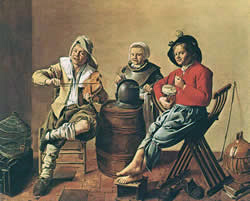
Jan Miense Molenaer
1629
Oil on canvas, 68.3 x 84.5 cm.
National Gallery, London
The boy to the left is playing a fiddle, cheerfully accompanied by the girl using an old helmet as a drum by beating it with two spoons, and another boy making a funny rhythmic sound with a rommelpot.
Between 1700 and 1716, the Oude en nieuwe hollantse boerenlieties and contredansen ("Old and new Dutch peasant songs and country dances") was published in Amsterdam."Oude en Nieuwe Hollantse Boerenlieties en Contredansen" is a significant collection of Dutch folk songs and dances from the 17th and 18th centuries. It includes a variety of peasant songs ("boerenlieties") and country dances ("contredansen") popular among the Dutch people during this period. The collection offers valuable insights into the cultural and social life of the Netherlands, particularly reflecting the musical traditions of the lower and middle classes. These songs and dances, integral to celebrations and social entertainment, highlight the everyday life and festivities of the Dutch Golden Age. This compilation is not only important for understanding historical music and dance forms but also serves as a crucial resource for preserving Dutch folk traditions. This volume is the largest collection of its kind ever published in the Low Countries. It contains more than one thousand melodies, many of French and English origin. It would appear that until about 1700 there was no noteworthy difference between instrumental and vocal music. Contrary to the refined polyphonic style (two or more homogeneous voices) of the music written by professional composers for the upper class or Imperial Court, folk music was essentially monodic (only one voice for the melody) accompanied only by a few chords of another instrument. Music was frequently accentuated with a percussion instrument to clearly mark the rhythm (fig. 8).
But songs were not only meant as entertainment or distraction from the grueling hardships of life. They provided regular rhythm necessary for woodcutters, sailors and blacksmiths. Maids entertained themselves with singing during their tedious housework, hence the existence of thousands of kitchen songs. And almost any of us knows at least one or two old lullabies which helped mothers to put their children to sleep at night.
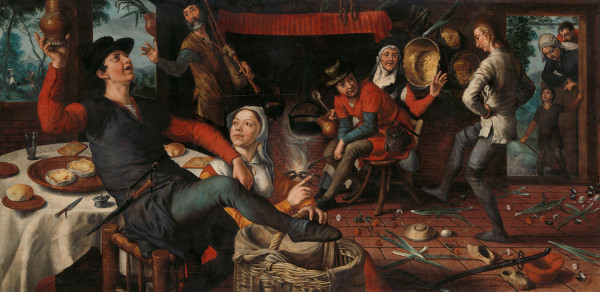
Pieter Aertsen
1552
Oil on panel, 84 x 172 cm.
Rijksmuseum Amsterdam
Each festivity had its special game- and dance-songs, even the secular feasts like May Day when the populace danced around the maypole or at midsummer around bonfires. Some of these dances had amorous intentions allowing the partner a touch or even a kiss, like 't patertje, a popular kissing dance. Other dances required considerable physical skills, like sword-dances or the eierendans ("egg dance") (fig. 9 & 10), popular in the Netherlands at Easter as it is evident from various period paintings. An early, detailed example comes from Pieter Aertsen (1508–1575), another one from Pieter Brueghel the Younger (1564–1638), apart from Jan Steen's lively depiction. In this dance, green leaves and early flowers were strewn on the floor. A circle was drawn with chalk in which one or more eggs were laid, sometimes in a little dish. The participants were allowed only to dance on one foot, with their hands on their sides. While dancing they had to move the egg out of the circle and back into it again with their feet, leaving the egg intact.
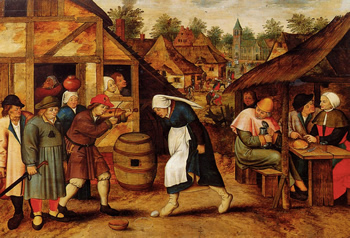
Pieter Brueghel the Younger
c. 1620
Christie's Images/Bridgeman Art Library
The egg dance was a traditional Easter game involving the laying down of eggs on the ground and dancing among them whilst attempting to break as few as possible. Another variation (depicted in many of the images featured here) involved tipping an egg from a bowl, and then trying to flip the bowl over on top of it, all with only using one’s feet and staying within a chalk circle drawn on the ground. Although, as shown in many of its depictions in art, the pastime is associated with peasant villages of the 16th and 17th centuries, one of the earliest references to egg-dancing relates to the marriage of Margaret of Austria and Philibert of Savoy on Easter Monday in 1498.
from: "The Egg Dance: From Peasant Village to Political Caricature," The Public Domain Review. https://publicdomainreview.org/collections/the-egg-dance-from-peasant-village-to-political-caricature/
In the northern part of the Netherlands, mainly in Friesland, schotz or schots were popular and rhythmically related to Scottish dance music. In the second half of the nineteenth century, the skotse trije ("Scottish three") became the "national" dance of Friesland. Although originally danced by three participants, by the end of the century it had evolved into a square dance.
Shortly after 1815, the first waltzes appeared, followed by polka and mazurka (middle of the nineteenth century) which soon conquered even the remotest villages. The structure and orchestration of this music became more complex, with wind and mixed bands giving a first and second part, off-beat chords and a bass.
After World War I, folk music and dancing was revived to defend the youth from the imported modern music and American dances, at the same time bolstering local cultural heritages.
Despite of the flood of modern influences brought by the radio, TV and internet, an unbroken interest in traditional folk dancing and music persists in many areas. Whenever a folklore group performs they draw enthusiastic crowds. Every province has a long list of folklore groups and children's groups as well.
Click here for period music:
(sung and danced by men and women in Leeuwarden, province of Friesland)
The melody has a great resemblance with those in Scotland and Scandinavia. People take it for granted that "skotse trije" means "scottish three" and that the dance came from the Scottish brigades who were more than two centuries (1575–1783) in Friesland. But as the Frisians, especially the town Stavoren, had also connections with Scotland around the year 1000 it may be that the dances were already known then.
As Holland had a lively trade with the Scandinavian countries it is possible that the sailors brought the dances up to the North even to Iceland and Lapland. The Scandinavian name skotar reminds of the origin.
:
Folksongs and Dances of the Netherlands. Collected and notes by Wilhelmina D. Sheepers.
Folk dancing in the Netherlands today:
Henriks Mazurka – The tune for this dance was written by Henrik Holm as a gift for Elsche on the occasion of her 40th birthday. Henrik is of Swedish nationality. He was a member of the display team Pieremachochel for many years.
(Video: Performed by members of the Dutch display team Pieremachochel) from:
Homepage Elsche Korf
Online-information about folk dancing in the Netherlands(with detailed links to local groups by province): Folk Dancing in the Netherlands
Organizations / Volksdansverenigingen
Suggested listening:
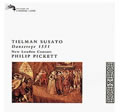
Dansereye (1551)
von Philip Pickett (Künstler), Nlc (Künstler), Tielman Susato (Komponist), Philip Pickett (Dirigent)
Tielman Susato
available at: amazon.com - amazon.de
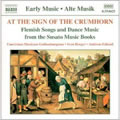
At the Sign of the Crumhorn. Flemish Songs and Dance Music from the Susato Music Books
Am Zeichen des Krummhorns (Flämische Lieder und Tänze aus den Sammlungen des Verlagshauses Tielman Susato)
available at: amazon.com - amazon.de
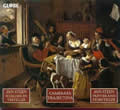
Jan Steen—Schilder en Verteller (Jan Steen—Painter and Storyteller)
Camerata Trajectina
Traditionele muziek uit Vlaanderen / Traditional Music from Flanders
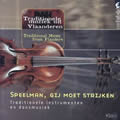
Speelman, gij moet strijken: Traditionele instrumenten en dansmuziek
1335
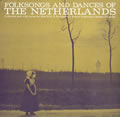
Folksongs and Dances of the Netherlands
Collected by Wilhelmina D. Scheepers.
1963.
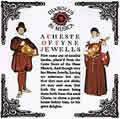
A Cheste of Fyne Jewells (Dances and tunes from the Elizabethan Era, played on period instruments)
Diabolus in Musica
available at: Diabolus in Musica
http://www.diabolus.org/studio/cheste.htm ( email: paul@diabolus.org)